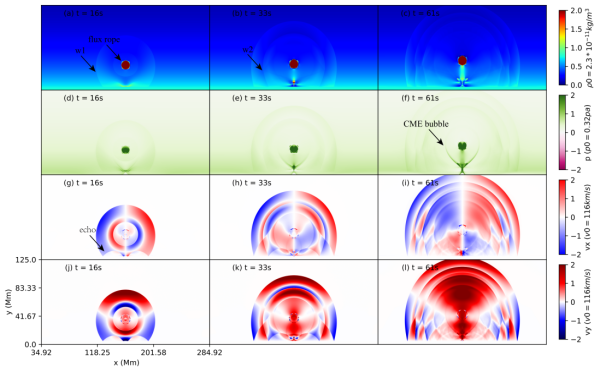A recent publication in The Astrophysical Journal reveals a groundbreaking study by PHD student HU Jialiang, Prof. LIN Jun from Yunnan Observatories (YNAO), CAS, and other co-authors. The research proposes a new mechanism for the generation of large-scale quasiperiodic fast-propagating (QFP) magnetoacoustic waves on both sides of coronal mass ejection (CME).
The magnetized solar atmosphere, a highly structured medium, supports various types of wave generation and propagation. The quasi-periodic wave trains in the corona (QFP waves) are coronal disturbance phenomena observed by the Atmospheric Imaging Assembly (AIA) on the Solar Dynamics Observatory (SDO). These wave fronts, interpreted as fast-mode magnetoacoustic waves, consist of continuous, narrow arc structures, capable of rapid propagation at speeds up to 1416 km/s.
Based on current observational constraints, the origin of QFP waves remains unclear. Numerous mechanisms have been proposed to explain the relationship between CMEs or flares and QFP waves, but a definitive conclusion has not yet to be reached.This research sheds new light on the origin of QFP waves.
The team's numerical simulations reveal that magnetic flux rope containing helical magnetic structures exhibits waveguide properties. When surrounding coronal magnetic structures destabilize, oscillations occur within the flux rope. Since the magnetic flux rope is not a perfect waveguide, the internal oscillations propagate to the boundaries and partially leak into the surrounding corona, forming the observed QFP waves. To gain a deeper understanding of the origin of QFP waves, the researchers analyzed the propagation characteristics of disturbances by calculating velocity divergence at different times, yielding results consistent with observations.
Furthermore, synthetic images based on simulated data in extreme ultraviolet and white light highly reproduce actual observational results. This consistency of the simulation result with observation demonstrates that the leakage of internal disturbances from the flux rope, acting as a waveguide, forms a multi-wavefront structure and represents a reasonable mechanism for the generation of QFP waves.
This work was supported by the National Key R&D Program of China; grants associated with the Yunling Scholar Project of the Yunnan Province, the Yunnan Province Scientist Workshop of Solar Physics, the Applied Basic Research of Yunnan Province, and the Yunnan Key Laboratory of Solar Physics and Space Exploration of Code. The numerical computation in this paper was carried out on the computing facilities of the Computational Solar Physics Laboratory of Yunnan Observatories (CosPLYO).

Figure 1, evolutionary characteristics of QFP waves at different times. Each row represents density, pressure, horizontal velocity, and vertical velocity respectively, image by HU.

Figure 2, evolutionary diagram of velocity divergence at different times. "b" denotes the boundary of the magnetic rope, "p" represents disturbances generated inside the magnetic rope during the eruption. "w1" and "w2" indicate the two wave fronts generated by disturbances leaking outside the magnetic rope.), image by HU.

Figure 3, comparison between observational and simulation results. The top row presents the observational data, while the middle row displays the simulation results. Figures (i) and (j) are zoomed-in sections of velocity divergence, revealing details within the regions outlined in boxes (g) and (h) respectively, image by HU.
Contact:
HU Jialiang
Yunnan Observatories,CAS.
Email: hujialiang@ynao.ac.cn